The pecs are large fan-like muscles with two heads — the clavicle and the sternal head. But we know you’re not here for an anatomy lesson; you’re here for lower chest exercises and lower chest workouts.
Some people say you can’t isolate different parts of your chest, and we’re here to bust that myth. Here are the 6 best lower chest exercises and a few of the best lower chest workouts you can do, according to our expert training staff:
6 Best Lower Chest Exercises
- Decline Bench Press
- Dip
- Decline Dumbbell Flye
- Cable Crossover
- Decline Push-Up
- Dumbbell Hip Extension Floor Press
Recent Updates: BarBend Senior Writer Jake Dickson revisited this list and made amendments to better reflect BarBend’s ever-evolving standards in prescribing best-in-class, evidence-based training advice. Read more about that process here.
1. Decline Bench Press
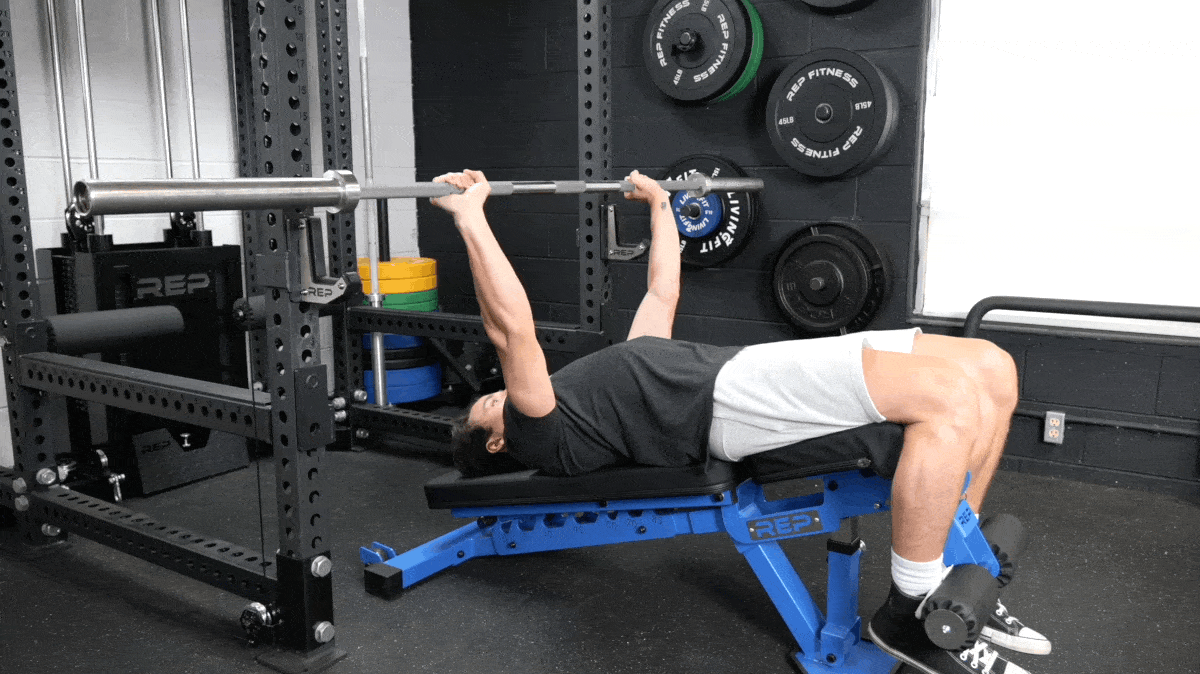
| Equipment Needed | Decline bench press station or adjustable weight bench, barbell, weight plates, wrist wraps (optional) |
| Muscles Worked | Pecs, triceps, shoulders |
| Sets & Reps | 4 x 6-8 |
The decline bench press is often overlooked in favor of the flat or incline version. And that’s a shame because you’re leaving gains on the table if you aren’t including this one in your lower chest workouts.
“The decline bench press changes the angle of your pressing path to align a bit better with the muscle fibers of the lower chest,” says BarBend Senior Writer and personal trainer Jake Dickson.
How To Do It
- Lie face up on a decline bench with the feet secured to avoid sliding off the bench.
- Get your eyes underneath the barbell, take a wider than shoulder-width grip, and set your shoulder blades together.
- Allow the shoulder and elbow joints to bend as you lower into the bottom of the press, with the elbows underneath the barbell.
- When in the bottom position, press the barbell back up to lockout position and repeat.
Modifications
- Make It Easier: Try doing the reverse-grip bench press on a decline if this move is too uncomfortable on your shoulders.
- Make It Harder: Pause in the bottom position to emphasize the stretch.
2. Dip
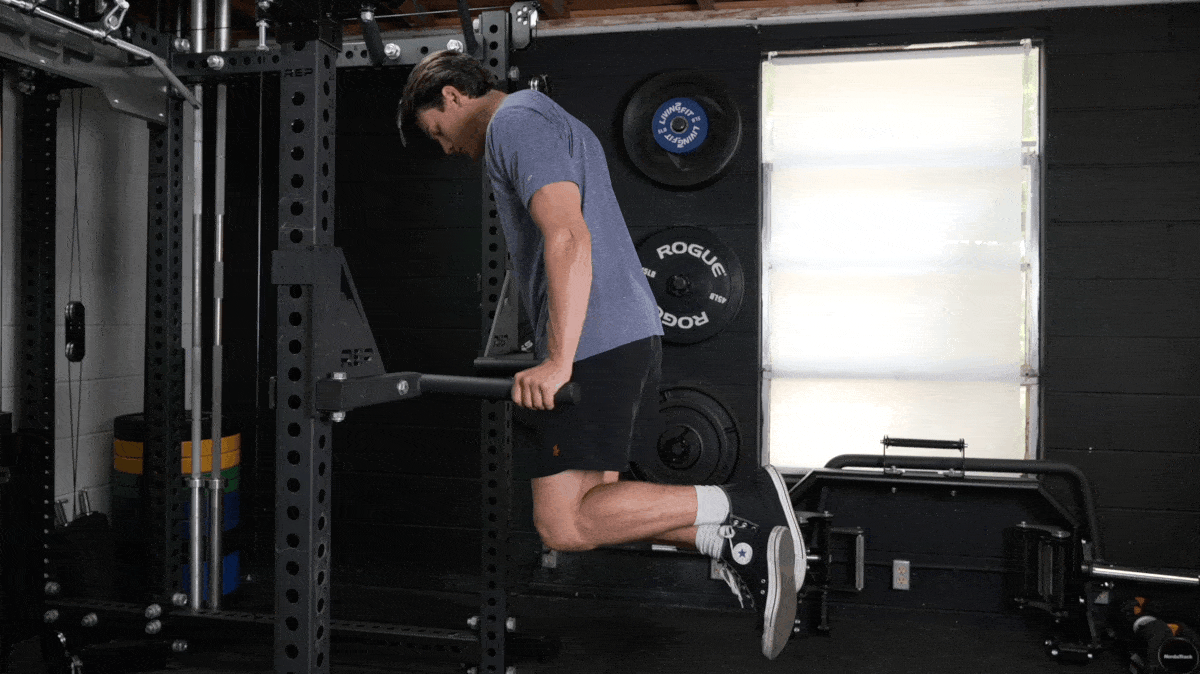
| Equipment Needed | Dip bars or chair |
| Muscles Worked | Triceps, chest, shoulders, core |
| Sets & Reps | 2-3 x 10-15 |
Dips are often referred to as the squats of the upper body — they target all of the major muscles in your upper body and can be easily scaled to suit beginners and advanced lifters alike.
[Read More: Ring Dips vs Bar Dips: Which Dip Is Best for You?]
“The long range of motion of the dip puts a greater stretch on the lower chest and triceps for more strength and hypertrophy potential,” says Dickson.
How To Do It
- Stand between the dip bars and grip firmly, and engage the upper back by keeping your chest up and shoulders down.
- Squeeze the bar and press yourself upwards while maintaining a forward lean to target the lower chest.
- When approaching lockout, flex the back of your triceps, pause for a second, and slowly lower down and repeat.
Modifications
- Make It Easier: Do dips off a chair with your feet on the floor, which will support your lower body and make the move easier.
- Make It Harder: Add weight with a dip belt or hold a dumbbell between your feet to introduce some progressive overload.
3. Decline Dumbbell Flye
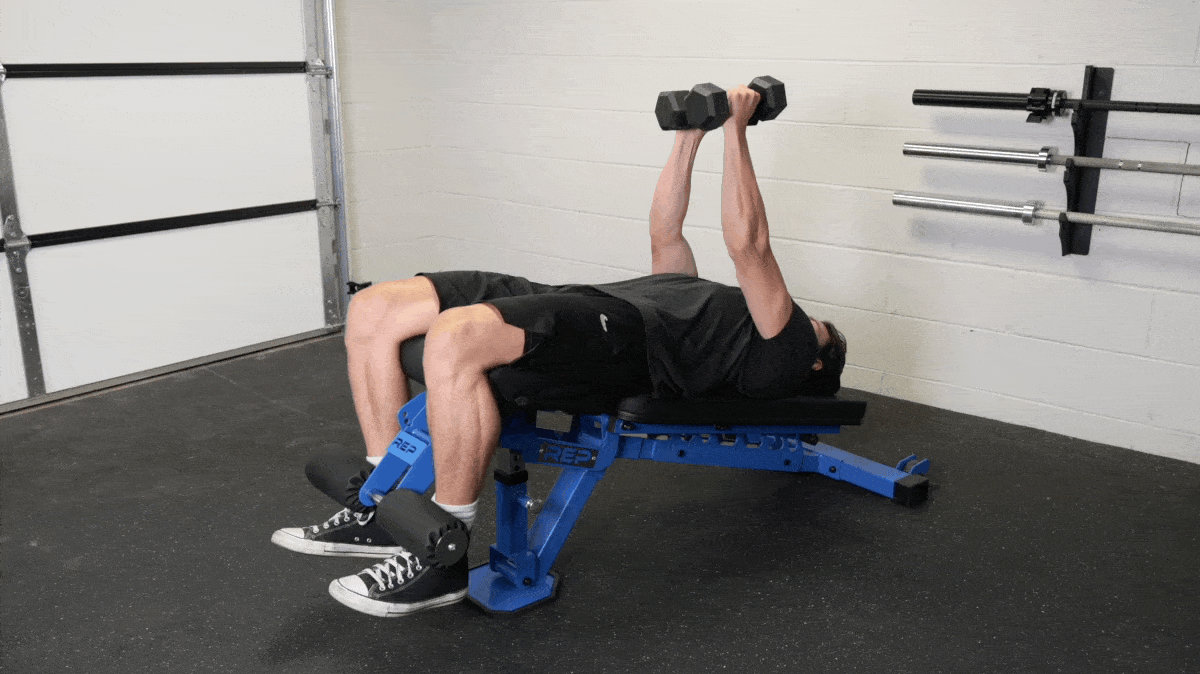
| Equipment Needed | Adjustable weight bench, dumbbells |
| Muscles Worked | Lower chest |
| Sets & Reps | 2-3 x 12-15 |
The decline flye is a stellar lower chest dumbbell exercise. Like the decline bench press, this exercise decreases strain on the anterior shoulders compared to the incline version. Because the triceps and shoulders are less involved, this isolates the lower chest muscles even further.
How To Do It
- Lie supine on the decline bench with a pair of dumbbells held using a neutral grip near your chest and with your feet secured at the end on the bench.
- Then, press the weights to the lockout position.
- Lower the weights laterally, maintaining a slight bend at your elbows to avoid elbow strain.
- When the dumbbells are at chest level, squeeze your chest muscles, bring the weights back to the starting position, and repeat.
Modifications
- Make It Easier: Bend your elbows a bit more to bring the weights in closer to your body.
- Make It Harder: Pause at the bottom of each rep to emphasize the stretch.
4. Cable Crossover
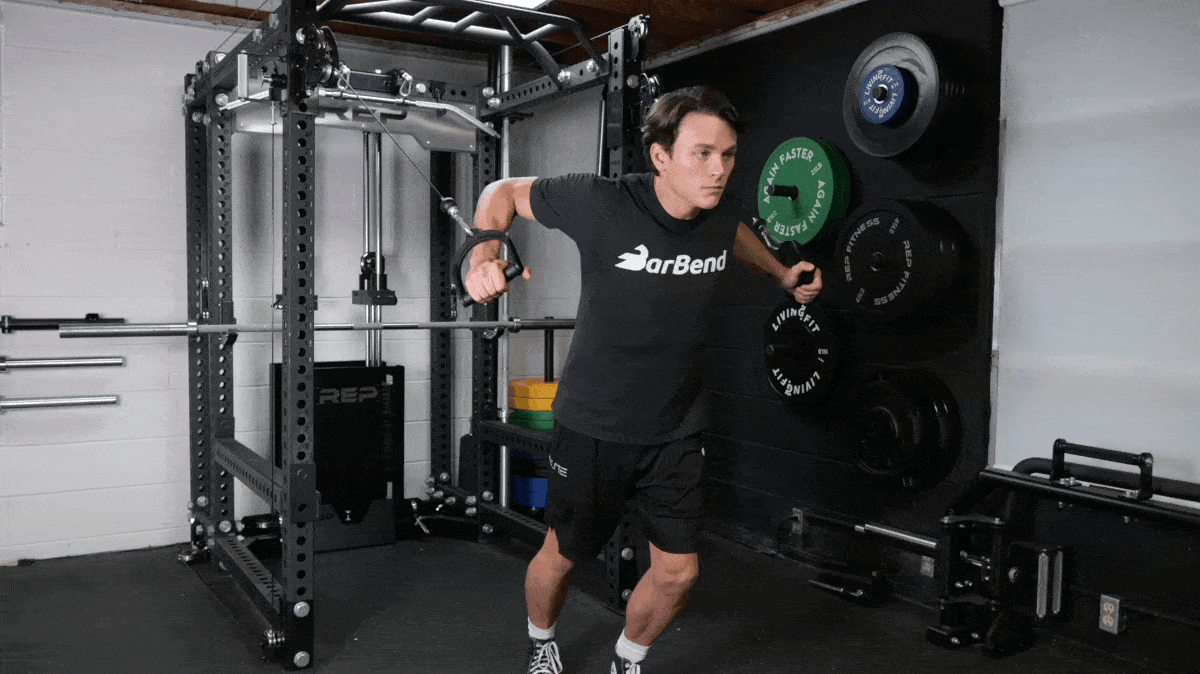
| Equipment Needed | Adjustable cable station |
| Muscles Worked | Chest, core |
| Sets & Reps | 3 x 12-15 |
The cable crossover and cable flye are the same thing, for the most part. If you cross your hands over each other at the end of each rep, you’re technically doing a crossover.
“When it comes to the cable crossover for building your lower chest, you don’t necessarily need to worry about crossing your hands,” Dickson says. “Just make sure the cables are set high up and you’re drawing your hands down and inward.”
How To Do It
- Set the handles at both ends of the cable machine at the highest level. Stand in the center with a staggered stance and take hold of both handles.
- Lean your torso forward, keeping your spine in neutral, and bend your elbows slightly too.
- Keeping your core tight, pull both handles down and across your body and squeeze the chest muscles at the end of this movement.
- Slowly reverse to the start position, keeping the bend in your elbows, and repeat.
Modifications
- Make It Easier: Stagger your feet to improve your balance and core stability.
- Make It Harder: Try doing one-and-a-half reps to get extra volume in the stretched position.
5. Decline Push-Up

| Equipment Needed | Weight bench or plyo box |
| Muscles Worked | Chest, shoulders, triceps |
| Sets & Reps | 2-3 x 15-20 |
The classic push-up will never go out of style — and by adjusting the angle, you’ll get a decline push-up. When you put your feet on an incline, your chest will be in a declined position.
[Read More: A Push-Up Training Program for Beginners]
As with many push-up variations, you can potentially rep out for added volume. The higher the volume, the better your lower chest muscle-building potential.
How To Do It
- Kneel with a bench, box, or step behind you. Place your toes on the bench.
- Walk out into the push-up position. Place your hands underneath your shoulders, squeeze your glutes, and screw your hands into the ground.
- Slowly lower down until your chest is about an inch from the floor. Drive your hands through the floor and lock out your elbows.
Modifications
- Make It Easier: Lower the height of the box you place your feet on to improve your leverage.
- Make It Harder: Try adding a few clapping push-ups at the start of each set to train power.
6. Dumbbell Hip Extension Floor Press
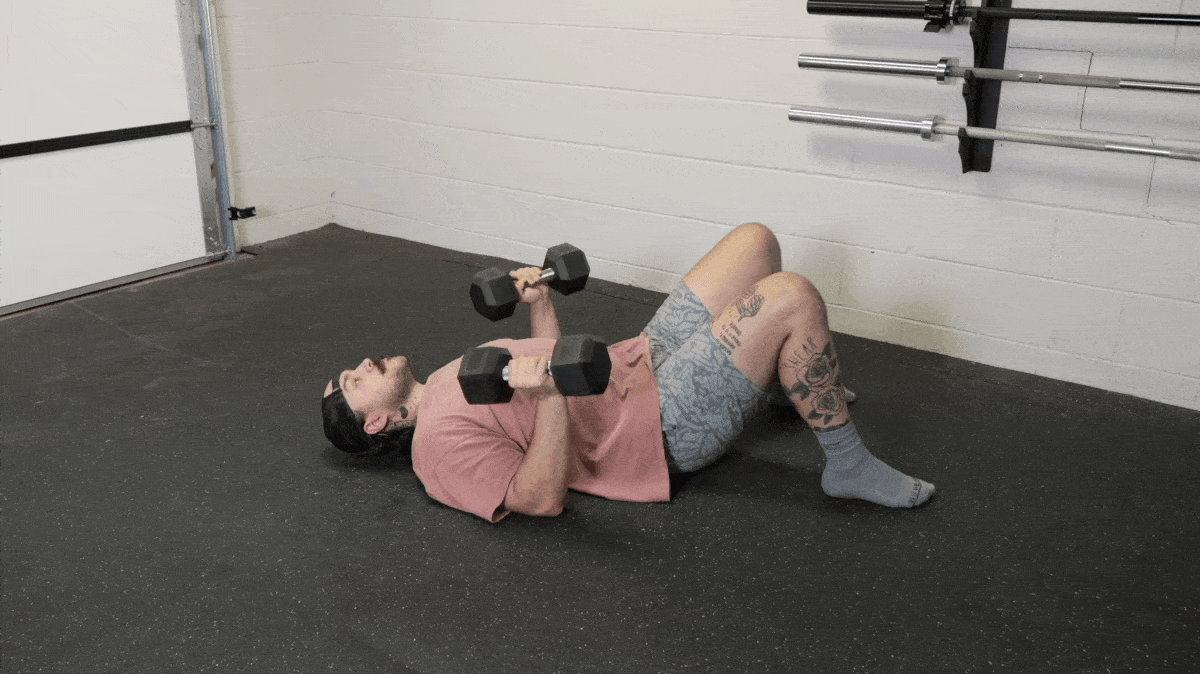
| Equipment Needed | Exercise mat (optional), dumbbells |
| Muscles Worked | Chest, shoulders, triceps, core, glutes |
| Sets & Reps | 3 x 15 |
If you don’t have a decline bench, the dumbbell hip extension floor press is also a great option. We like this move because it simulates a decline angle for your chest. Here, you’ll train the lower chest muscle fibers while improving hip mobility and glute strength, making this one of the best lower outer chest exercises you can do.
[Read More: Dumbbell Complexes for Fat Loss]
Plus, because you’re pressing with dumbbells, you’ll help strengthen imbalances between sides for better muscle development. This is a relatively safe and easy variation to perform — and you don’t need a decline bench to do it.
How To Do It
- Lie on the floor holding a dumbbell in each hand with a neutral grip.
- Plant with your feet flat on the floor. Place your elbows away from your torso.
- Press your feet through the floor and raise your hips into extension.
- Press the dumbbells up until your elbows are locked out. Slowly return until your upper arms touch the floor.
Modifications
- Make It Easier: Hold the dumbbells in a neutral, palms-facing-each-other position.
- Make It Harder: Lie with your spine on a foam roller to provide extra range of motion for your arms.
3 Best Lower Chest Workouts
If you want to prioritize growing or strengthening your lower chest, we’ve got you covered. The lower pecs are often a physique weak point for bodybuilders, and even if you don’t aspire to the stage in the future, there’s no reason to overlook any individual muscle or muscle group. Try this lower chest workout:
Lower Chest Warm-Up
Performing some light sets or ramp-up sets with exercise you’re about to do is one way to warm up. Not only will ramping up sets grease the groove and help you decide your working weight for the day, but the extra volume is helpful for fat loss and hypertrophy goals. Here’s an example of ramp-up sets for the decline bench press:
- 10 reps with an empty barbell
- Eight reps with 135 pounds
- Six reps with 155 pounds
- Five reps with 165 pounds
- Four reps with 175 pounds
[Read More: The Best Upper Body Workouts for Strength, Muscle, Bodyweight Training, and More]
Another way is to do some upper body drills that train shoulder and thoracic mobility to get the blood moving through these important areas. Exercises like an inchworm with a push-up, spiderman with rotations, wall slide, band-pull apart variations, and front and side planks are great to train before training the lower chest.
Best Lower Chest Workout
We’ve designed this lower chest workout to emphasize that specific region of your pecs while still building general upper-body muscle and strength in the process.
This workout incorporates free weights, cables, and calisthenics moves, so you’ll need access to a fully-furnished gym.
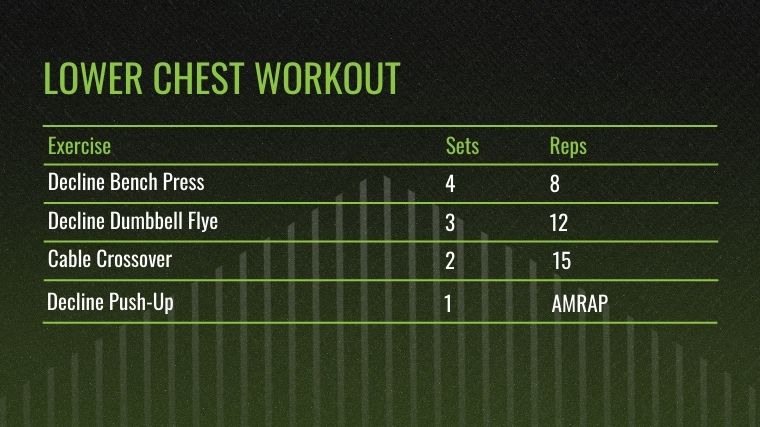
- Decline Bench Press: 4 x 8
- Decline Dumbbell Flye: 3 x 12
- Cable Crossover: 2 x 15
- Decline Push-Up: 1 x AMRAP
“There’s no reason to forego balanced chest training, even if you want to bring up your lower chest specifically,” Dickson notes. “Small changes to common bodybuilding chest exercises to place your lower chest in the crosshairs should do the trick.”
Dumbbell Lower Chest Workout
This is the best lower chest workout you can do with dumbbells, period. While it may not be as robust as other chest workouts, these three lower chest dumbbell exercises are all you need to round-out and strengthen your pecs.
You’ll start with a compound exercise for your lower chest and work your way towards a brutal as-many-repetitions-as-possible workout finisher. Intensity techniques such as AMRAPs have been shown to be effective in boosting muscle growth, according to some research. (1)
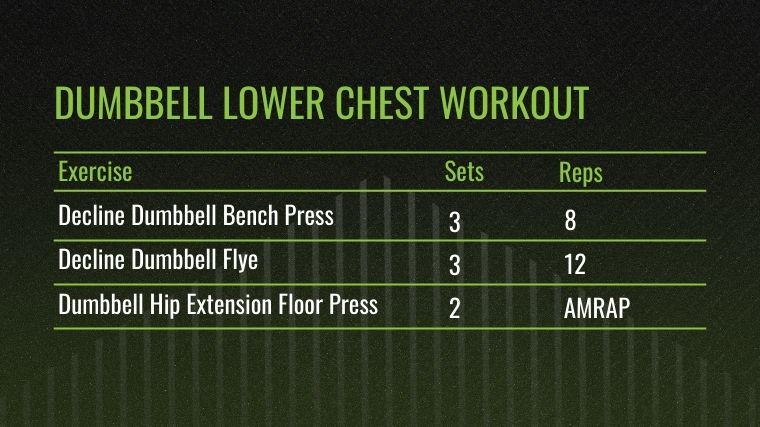
- Decline Dumbbell Bench Press: 3 x 8
- Decline Dumbbell Flye: 3 x 12
- Dumbbell Hip Extension Floor Press: 2 x AMRAP
Lower Chest Workout at Home
No time to hit the gym? No worries, we’re serving up a lower chest workout at home that you can do with limited equipment.
While weight training equipment and heavy lifting are essential to maximizing muscle growth, studies show that you can perform time-efficient workouts with limited equipment and still gain muscle as long as you up your rep count and consider reducing your rest periods. (2)
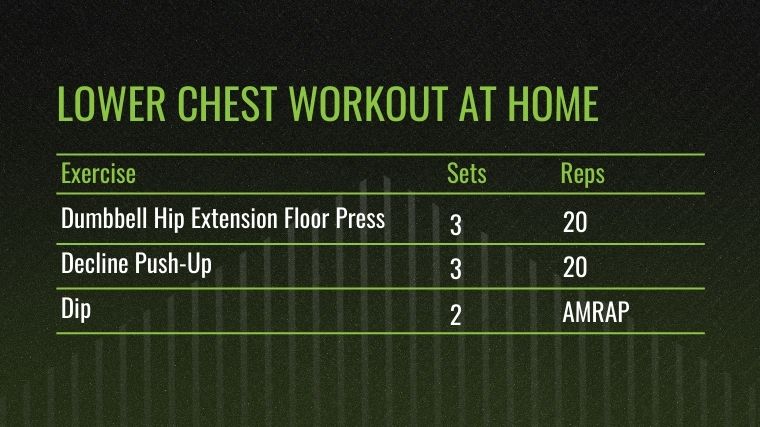
- Dumbbell Hip Extension Floor Press: 3 x 20
- Decline Push-Up: 3 x 20
- Dip: 2 x AMRAP
What Muscles Make Up the Lower Chest
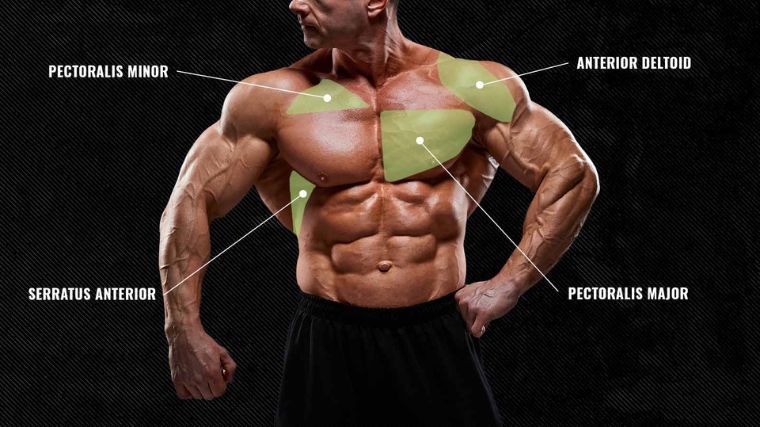
Your chest is a large superficial muscle running at different angles with multiple attachment points. Understanding what they are and how they work is important in obtaining a stronger chest. The chest is made up of two muscles, the pectoralis major and the pectoralis minor muscle.
- Pectoralis Major: A large superficial muscle located on the anterior surface of the thoracic rib cage. Has two major heads, the clavicular head, which is in the upper region of the chest, and the sternal head is in the middle to lower chest region.
- Pectoralis Minor: A superficial muscle on the anterior aspect of the chest, located deep to the pectoralis major muscle.
“Myth” Busted: There’s no distinct anatomical compartment of the pecs called the “lower chest”; when discussing lower chest exercises, people are generally referring to movements that target the bottom region of their chests overall. That said, you can still emphasize that region of your chest, even if it isn’t anatomically unique, by adjusting how you perform common chest exercises.
How To Train Your Lower Chest
Bear in mind that your lower chest isn’t a separate muscle altogether; it is a region of your pecs that you’re looking to give a bit of extra love to. As such, you probably don’t want to dedicate an entire day in your weekly workout split to your lower pecs. Follow standard progression rules, make some specific exercise swaps, and you’ll be well on your way.
- Exercise Selection: Replace your existing pressing exercises with lower-chest-friendly variations, such as swapping the decline bench press in for the flat bench.
- Sets and Reps: Do 1 to 3 compound exercises and 2-4 sets per exercise, anywhere from 6 to 12 reps. For isolation moves, do 1-3 sets of 8-15 repetitions.
Here are some more specific training tips for your lower chest to help you get the most value out of your workouts:
Find the Right Angle
Your muscles are a series of levers and pulleys, and they all obey the laws of physics. As such, certain areas of your chest are liable to perform more work depending on the angle of the surrounding joints. In short, this means that your lower chest will get off the bench and into the game if you take time to find a pressing angle that consciously stimulates those fibers.
Use Pre-Exhaustion
When it comes to any exercise that involves more than one muscle group, you’re only as strong as your weakest link. On the bench press, for instance, your triceps or shoulders may be the rate limiters — they fail first, preventing you from stimulating all the fibers in your pecs during your set.
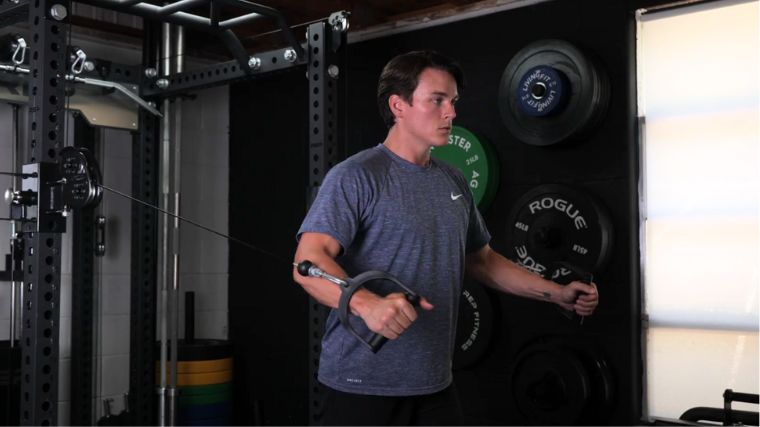
[Read More: Is Pre-Exhaust Training Right for You? What It Is and Tips From a Pro]
You can get around this by performing some pre-exhaustion exercises instead. This method involves doing movements that directly target your “supplemental” muscles first. On chest day, this can look like beginning with triceps pressdowns or front raises before hitting up the bench press.
Benefits of Training Your Lower Chest
Besides building a bigger and fuller chest, there are many important benefits from focusing on your lower chest (and your chest in general).
Improved Posture
As it’s one of the largest muscles in the upper body, the chest plays a major role in assisting good posture as its length and strength dictate your shoulder position. The pecs, along with the upper back and shoulder, help to stabilize the entire shoulder joint.
Better Breathing
Strengthening and lengthening the chest muscles support deeper breathing through expansion and contraction of the ribcage.
“Your pecs attach to your ribcage, which expands with every breath, and if they are tight or short, this may affect your ability to breathe deeply,” Dickson notes.
Improved Athletic Performance
As the pecs are your hugging muscle, their size and strength help tackle and fend off opponents of the football field. And they assist in hitting a tennis ball, throwing a football and baseball faster and harder.
Frequently Asked Questions
Do push-ups work the lower chest?
Standard push-ups won’t emphasize your lower chest, but you can do decline push-ups by elevating your feet onto a plyo box or bench to shift the emphasis toward that region of your pecs.
How often should I train my lower chest?
Your lower chest is a muscle like any other. If you’re performing chest workouts that focus intensely on that region, two weekly sessions is more than sufficient.
How many exercises should I do for the lower chest?
Your best bet is to perform up to three compound movements (such as the decline bench press or dip) for your chest and one or two additional isolation exercises like dumbbell flye or cable flye afterward.
References
- Krzysztofik M, Wilk M, Wojdała G, Gołaś A. Maximizing Muscle Hypertrophy: A Systematic Review of Advanced Resistance Training Techniques and Methods. Int J Environ Res Public Health. 2019 Dec 4;16(24):4897. doi: 10.3390/ijerph16244897. PMID: 31817252; PMCID: PMC6950543.
- Iversen VM, Norum M, Schoenfeld BJ, Fimland MS. No Time to Lift? Designing Time-Efficient Training Programs for Strength and Hypertrophy: A Narrative Review. Sports Med. 2021 Oct;51(10):2079-2095. doi: 10.1007/s40279-021-01490-1. Epub 2021 Jun 14. PMID: 34125411; PMCID: PMC8449772.
Featured Image: TeodorLazarev / Shutterstock